We decided to head to Leeuwarden today, and boarded a train which wound its way through typical Dutch landscape: endless, lush, green fields under big open skies, the fields laced with networks of drainage channels, occasionally occupied by large numbers of horses and cows. Our carriage was occupied by a large number of German youths, evidently returning from one of the Frisian islands. Occasionally we caught glimpses of the Van Harinxmakanaal which Rex, Meryl and I had sailed up in 2013.
Once in the city of Leeuwarden, we made our way up to the Wilhelminaplein, which today was crammed with market stalls. Rex was particularly attracted to those stalls that sold brushes and cleaning implements; perhaps a hint that I hadn't been scrubbing the decks lately. He was highly excited, so I dragged him into one of the coffee shops that skirted the market. There he enjoyed coffee and I fresh mint tea, and we engaged in that well known activity of people watching.
It gave us time to reminisce about the history of the city. Leeuwarden is the capital of Friesland and one of the historical eleven cities. It developed out of three terp or hill settlements that originally stood on an expanse of water known as the Middelzee. These merged in 1435 and were granted a municipal charter. Thereafter the town grew into an important trading center. With the silting up of the Middelzee, however, the town lost its harbour and became instead an agricultural market town and the chief center of the Ostergos region. From 1524 to 1580 the town was the seat of the Habsburg Stadholder, who was succeeded from 1584 to 1747 by Stadholders of the Nassau-Dietz family. In the 16th-18th centuries Leeuwarden was famed for its fine gold and silverware. Nowadays Leeuwarden is a modern city with a mostly 16th century city centre, with many canals and city walls (the structure of the city walls looks like a diamond) and museums. It is a university city with a laidback provincial air, its centre a haphazard blend of modern glass and traditional gabled terraces overlooking canals. It perhaps lacks the concentrated historic charm of many other Dutch cities, but it's an amiable old place.
Several notable people were born in Leeuwarden: the artist Escher, Saskia van Uylenburgh, Rembrandt's wife, and of course the city's most famous daughter, the spy Mata Hari (1876-1917). She was born Gertrud Zelle. Hari became a renowned "exotic" dancer after an early but unsuccessful marriage to a Dutch army officer. Although the Netherlands was neutral during World War I, Hari seems to have accepted a German bribe to spy for the kaiser. The French intelligence service soon got wind of the bribe - partly because she was also supposed to be working for them - and she was subsequently arrested, tried and shot. What she actually did remains a matter of some debate, but in retrospect it seems likely that she acted as a double agent, gathering information for the Allies while giving snippets to the Germans.
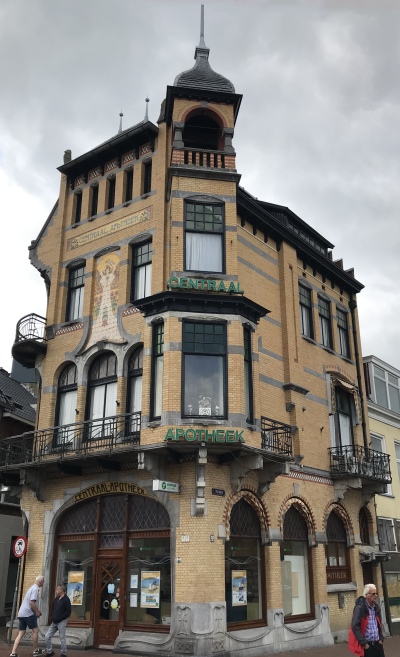 Centraal Apotheek |
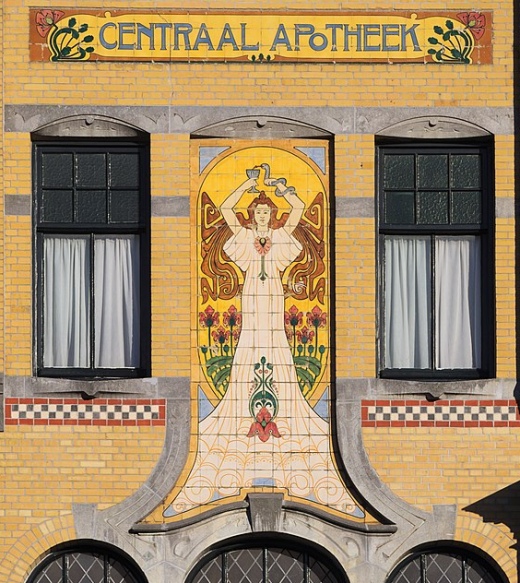 Centraal Apotheek Tableau |
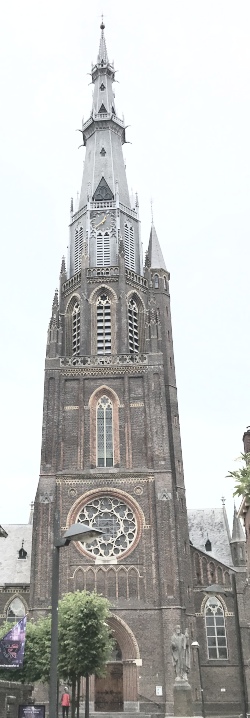 St Bonifatiuskerk |
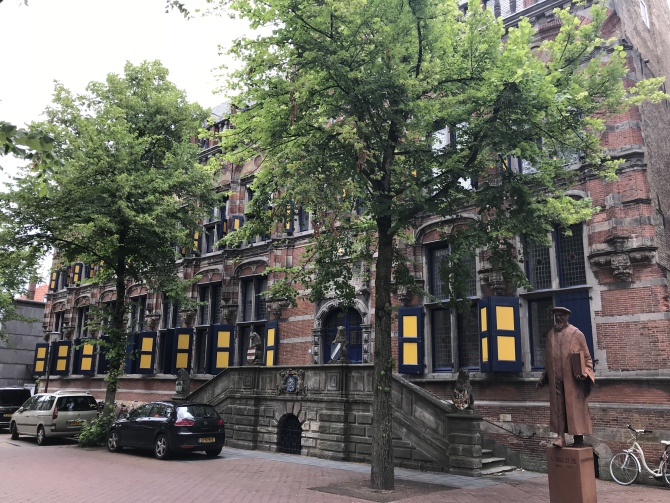 Kanselarij |
Since we were in the near vicinity of The Other Museum from Oldtimer to Lace, a museum we had visited and greatly enjoyed in 2017, we headed across to it. Of course, it was closed. Hmmm ... there seems to be a pattern building up here.
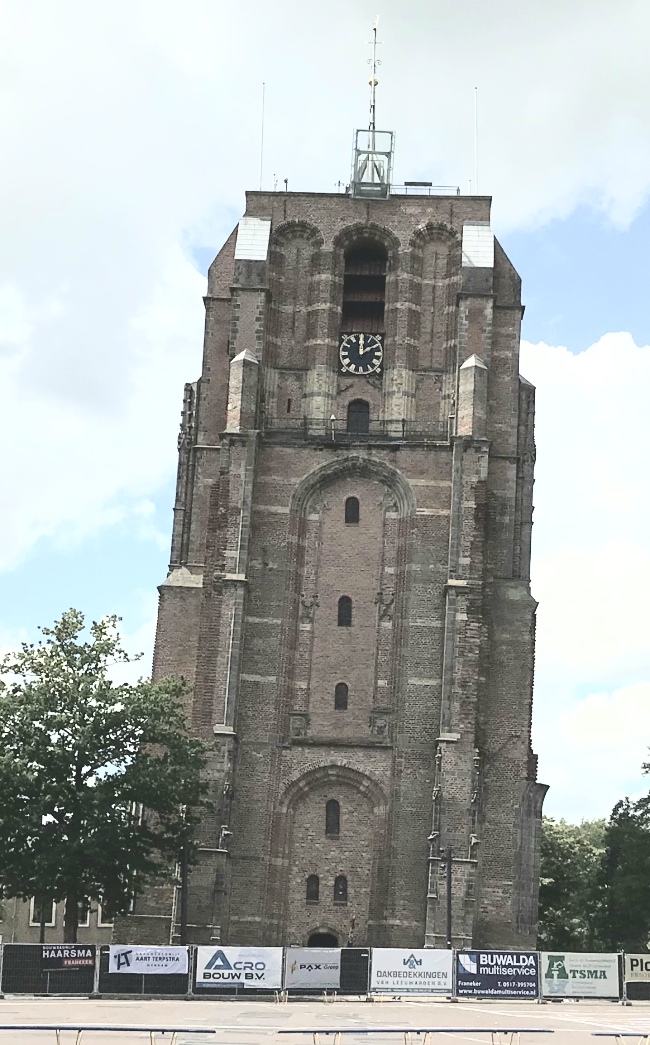 Oldehove |
There is a square, the Oldehoofsterkerkhof, situated at the foot of the leaning tower Oldehove. A long time ago there was a church on the Oldehoofsterkerkhof, and like the name suggests this used to be a cemetery. Some time ago the bodies in the graveyard were exhumed and now you can park your car in that very same spot in the underground parking garage. In the summer little fountains spew water over the square and its red cobblestones. The square in front of the Oldehove has been lowered so that in a period of frost a small layer of water will create an ice rink for recreational ice skating.
Today, on the square, was a BOSK exposition. Every day for a hundred days, between 7th May to 14th August 2022, a different part of the city centre of Leeuwarden would be coloured green. That is because over one thousand large and small trees would be walking around the city. This 'walking' forest would give the trees - and with them, nature - a voice: what can we learn from trees and how does the forest view the human world? There were all sorts of things going on in the walking forest, it was always dynamic. Residents, enterprises and local and international artists would all contribute. The aim was for the forest to play with your senses, and thanks to a dedicated team of hundreds of volunteers, it would create a new network of interconnected roots.
BOSK was more than just an impressive, mobile art installation, though. It was an arts project with a packed programme of performances and exhibitions that focused our attention on the urgent need to change our view of the relationship between humanity and nature. It ranged from a summer school for Leeuwarden neighbourhoods, a BOSK news programme for primary school pupils and a whispering garden full of inspiration, to a spectacular percussion show and dance performances that would knock you off your socks.
For 100 days, BOSK would also create space for everyone to make time for conversations, art and ideas. After a hundred days, the walking forest would leave Leeuwarden city centre. The trees would make their way to their final destinations. Dispersed throughout the city and in the surrounding areas, they would find fresh soil where they could put down roots and keep an eye on future generations.
After more tripping down memory lane, interspersed with copious coffees, we returned to Harlingen. There we briefly marvelled over the numerous tall ships berthed in the outer harbour, no doubt getting ready for the imminent Tall Ships Race.
Then, to the right of us, an enormous red ship glided past us, bristling with enormous chain bucket arms; obviously an enormous dredger heading back to its home country of Denmark. A tug attached by a rope to its stern helped to swing the giant ship around to line it up with the channel through the breakwaters.
Our evening followed a familiar routine, starting with a beer at De Lichtboei, where Rex spotted a Jimmy Tarbuck look alike - he really ought to go to Specsavers. Then we returned to the Nooitgedagt Restaurant for another delicious meal. Yesterday and today we ate upstairs. The stairs in this restaurant are similar to those on a ship - very steep. Old dears struggled up and down them, and even Rex admitted to going down backwards. How the waiters and waitresses coped with carrying food up and down I'll never know.
I sat facing Rex, with the open kitchen behind him. I was amazed at how it seemed to run like clockwork; each member of staff knowing exactly what they were doing with the minimum fuss. The manager did his fair share of waitering too.
We were whacked, and an early night was in order.
